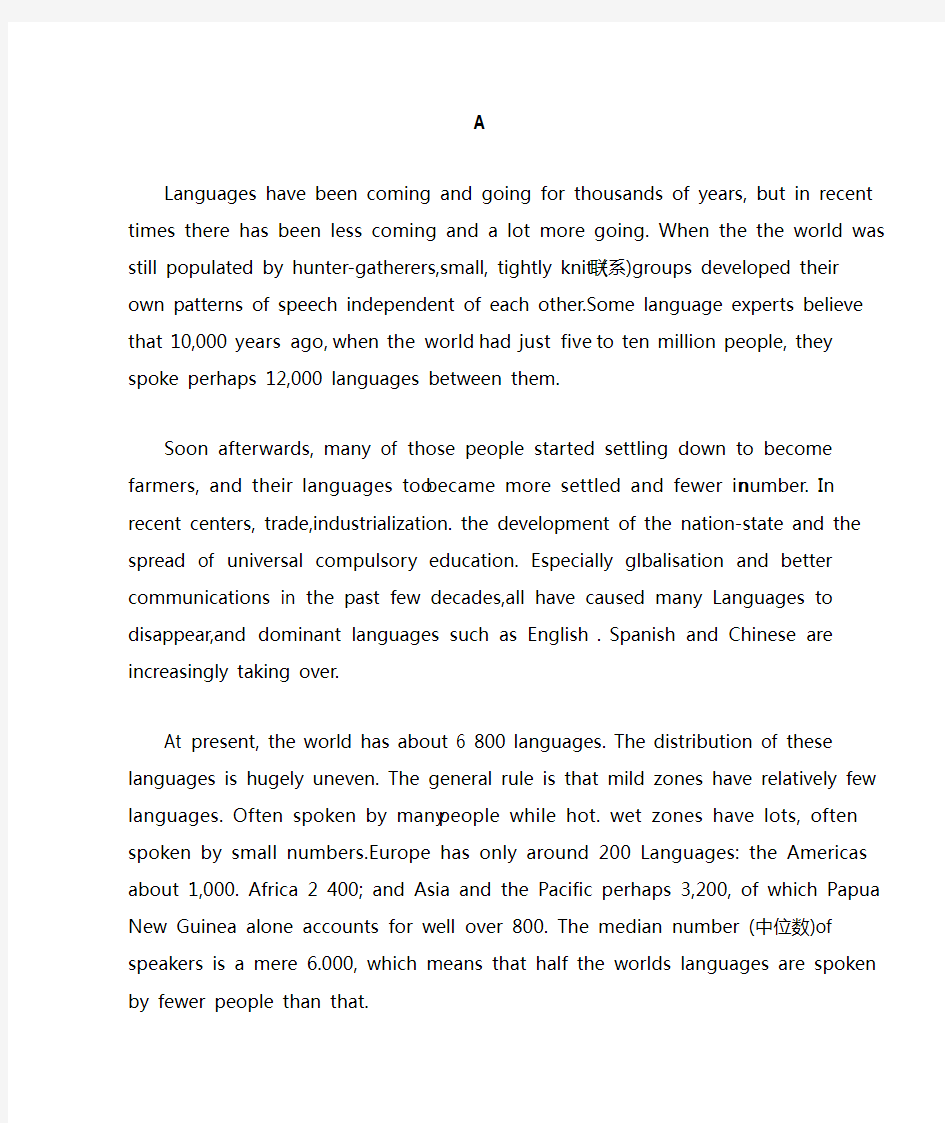高中英语阅读理解专项练习(含答案)

- 1、下载文档前请自行甄别文档内容的完整性,平台不提供额外的编辑、内容补充、找答案等附加服务。
- 2、"仅部分预览"的文档,不可在线预览部分如存在完整性等问题,可反馈申请退款(可完整预览的文档不适用该条件!)。
- 3、如文档侵犯您的权益,请联系客服反馈,我们会尽快为您处理(人工客服工作时间:9:00-18:30)。
A
Languages have been coming and going for thousands of years, but in recent times there has been less coming and a lot more going. When the the world was still populated by hunter-gatherers,small, tightly knit (联系)groups developed their own patterns of speech independent of each other.Some language experts believe that 10,000 years ago, when the world had just five to ten million people, they spoke perhaps 12,000 languages between them.
Soon afterwards, many of those people started settling down to become farmers, and their languages too became more settled and fewer in number. In recent centers, trade,industrialization. the development of the nation-state and the spread of universal compulsory education. Especially glbalisation and better communications in the past few decades,all have caused many Languages to disappear,and dominant languages such as English.Spanish and Chinese are increasingly taking over.
At present, the world has about 6 800 languages. The distribution of these languages is hugely uneven. The general rule is that mild zones have relatively few languages. Often spoken by many people while hot. wet zones have lots, often spoken by small numbers.Europe has only around 200 Languages: the Americas about 1,000. Africa 2 400; and Asia and the Pacific perhaps 3,200, of which Papua New Guinea alone
accounts for well over 800. The median number (中位数)of speakers is a mere 6.000, which means that half the worlds languages are spoken by fewer people than that.
Already well over 400 of the total of, 6,800 languages are close to extinction(消亡), with only a few elderly speakers left. Pick, at random, Busuu in Cameroon (eight remaining speakers),Chiapaneco in Mexico(150). Lipan Apache in the United States(two or three)or Wadjigu in Australia (one, with a question-mark): none of these seems to have much chance of survival.
28. What can we infer about languages in hunter gatherer times?
A.They developed very fast.
B. They were large in number.
C. They had similar patters.
D. They were closely connected
29. Which of the following best explains"dominant " underlined in paragraph 2?
plex.
B. Advanced.
C.Powerful.
D.Modem.
30. How many languages are spoken by less than 6, 000 people at present?
A.About 6 800
B.About 3 400
C.About 2.400
D.About 1-200
31. What is the min idea of the text?
A. New languages will be created.
B Peoples lifestyles are reflected in languages
C. Human development results in fewer languages
D. Geography determines language evolution.
28.B 29.C 30.B 31.C
B
Teens and younger children are reading a lot less for fun, according to a Common Sense Media report published Monday.
While the decline over the past decade is steep for teen readers, some data in the report shows that reading remains a big part of many chi ldren’s lives, and indicates how parents might help encourage more reading.
According to the report’s key findings, “the proportion (比例) who say they ‘hardly ever’ read for fun has gone from 8 percent of 13-year-olds and 9 percent of 17-year-olds in 1984 to 22 percent and 27 percent respectively today.”
The report data shows that pleasure reading levels for younger children, ages 2—8, remain largely the same. But the amount of time spent in reading each session has declined, from closer to an hour or more to closer to a half hour per session.
When it comes to technology and reading, the report does little to
